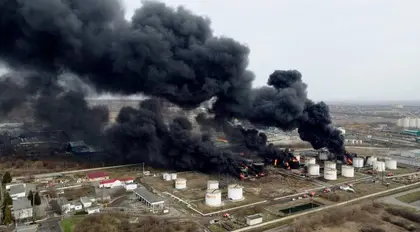It was not the first time unexplained nighttime explosions jerked villagers in Russia’s Belgorod Oblast out of their beds, but it was still a surprise.
Between 3:30 and 4:30 in the morning Wednesday, Apr. 27, light sleepers and earlier risers heard two quick explosions and then, according to RIA Novosti, a second, louder blast. People brave enough to step outside saw flames and smoke rising over a Russian army ammunition depot near the village in Staraya Nedilovka. Firefighters were unable to control the blaze and detonations were still echoing by mid-morning and audible fifteen kilometers away.
JOIN US ON TELEGRAM
Follow our coverage of the war on the @Kyivpost_official.
Belgorod Oblast’s governor Viacheslav Gladkov was up by 6 A.M. and issued a statement reassuring Belgorod residents as best he could.
“According to initial reports, an ammunition storage facility is on fire. There’s not been any damage to the residential building or home. There were no civilian casualties,” he said.
Like all other Russian Federation (RF) state-controlled media on Wednesday morning, Gladkov was silent on who, or what was responsible for setting off explosions seemingly targeting RF military facilities and energy industry infrastructure in Russian regions bordering Ukraine. As a cruise missile or strike aircraft flies, Ukraine’s border is about twenty kilometers from Staraya Nedilovka.
RF state TV less than six hours after the explosions were airing images of two young men dressed in black being dragged into a Belgorod police station. They admitted to the camera they were Russian citizens supporting Nazi ideology, which was why they send Ukrainian spies information about Russian army rail movements and possible military targets.
The RF news presenter reported to Belgorod’s citizens the two Ukrainian agents and saboteurs would answer for their crimes against Russia. She (and her station) made no mention of the last time extremely large explosions surprised Belgorod residents: When UAF attack helicopters, according to reports, in a daring 1 April strike flew into Russia and rocketed fuel storage facilities in the middle of the city. Those fires took three days to put out.
At the time Oleksiy Danilov, Ukraine’s National Security Council head, said he knew nothing about the helicopter raid and suggested Belgorod fuel storage site staff pay better attention to fire safety. On Wednesday morning, similarly, Ukrainian officials were silent on who or what caused the latest Belgorod blasts.
Flammable and explosive objects have been catching on fire or detonating, in Russia, at an alarming pace. On 23 April in Bryansk, 150 km from the Ukrainian border, an oil storage depot caught fire, as did buildings at a neighboring military base. Gas stations across the Bryansk region within hours saw massive queues as motorists rushed to top off fuel tanks.
Ukrainian media reported the Bryansk base manufactured long-range missiles used by Russia to bombard Ukrainian cities and hinted Ukrainian agents set the fire. More diligent Ukrainian news outlets noted a Bryansk meat-processing plant and an agricultural equipment factory also caught fire on the 23rd, leaving it to readers to decide how meat-processing and missile manufacturing might be linked. Meanwhile, the Bryansk governor’s office issued a statement with assurances that fuel supplies are sufficient, the situation is under control, and citizens should remain calm.
The same day – according to RF news reports across Russia’s thirteen time zones – an apartment building in St. Petersburg exploded, an airfield in Ussurisk and a shopping center in Moscow caught fire, and blazes broke out in police stations in Novosibirsk and Irkutsk.
Kremlin-controlled media have limited their reporting of basic descriptions of damage and the allegedly quick and efficient work of firefighters and rescue teams. This has, effectively, left explaining all the smoke, fire, and explosions to the imagination of the Russian blogosphere.
On 21 Apr. in Tver’ – a city deep in Russia a good 800 km. from Kyiv – a fire gutted a state-run military missile research institute, killing seventeen. The facility was responsible for the design and fielding of long-range Kinzhal missiles, with which the RF military has been bombarding Ukrainian homes and cities. Tver’s police have arrested no suspects. Internet theories on persons responsible, KP found, ranged from Russian scientists secretly sympathetic to Ukraine to intoxicated maintenance staff, to top-level managers covering up corruption, to British agents.
Journalist Andriy Tsaplenko, a reporter for the UNIAN news agency with deep experience in Russia, said another possibility is the Kremlin, wishing to stoke public fear and antagonism towards Ukraine, is behind at least some of these attacks.
You can also highlight the text and press Ctrl + Enter



